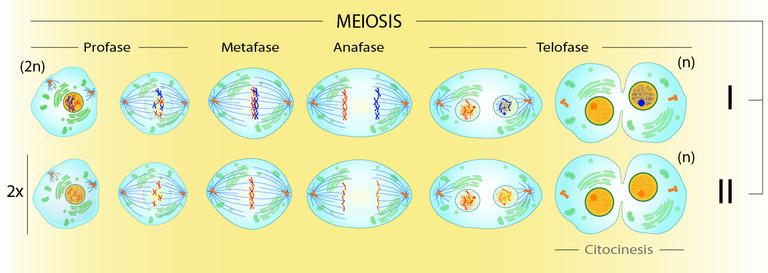Introduction
In my last post, we discussed what a typical cell cycle looks like and how a large part of the cycle is spent as interphase with a tiny percentage being spent in the active division, which is mitosis. Mitotic division only happens in vegetative or somatic cells. The cells that are concerned with sexual reproduction in sexually reproducing organisms divide in another form - meiosis.
Before talking about meiosis, it is imperative to understand the significance of mitosis in living organsisms. The division of the somatic/vegetative/non-sex cells of the body of organisms is important in several ways:
- Growth and development: an irreversible increase in the size of organisms can only happen through mitosis. As the cells divide and their number increases, so do the size of organisms. An increase in the size of organisms, however, can occur without an increase in the number of cells. The increase in the volume of the cells of the body can automatically bring about an increase in the size of the organism.
- Wound healing and cell replacement: when parts of the body of organisms become damaged due to injury, the cells of the tissues of the body regions are signaled to divide rapidly and this causes the regions to get healed. Without mitosis, it becomes impossible for wounds to get healed. Immunocompromised and old people whose body cells find it difficult to divide always have difficulty in getting healed of their wounds.
- Asexual reproduction: many unicellular and multicellular organisms can only reproduce through mitosis. Asexual reproductive processes such as fragmentation, budding, layering, etc. all depend on mitosis.
Meiosis and Sexual Reproduction
For sexually reproducing organisms, giving birth to young ones requires some chromosomal re-adjustment. Gametes containing half of the chromosomes of the parent are initially produced. The male parent produces the male gametes while the female parents produce female gametes. During fertilization, the male gamete (n) fuses with the female gamete (n) to produce a single cell zygote with a normal chromosome unit (2n). From there on, mitosis takes over and ensures that the zygote becomes a fetus and a proper baby.

The production of gametes with half of the chromosome number (haploid, n) of normal (diploid, 2n) organisms only happens through meiosis. This is why meiosis is referred to as a reductional division while mitosis is known as equational division. If diploid (2n) gametes are produced, the result of fertilization would be a 4n zygote instead of a 2n zygote.
Steps involved in meiosis
A cell undergoing meiosis would have to divide twice – meiosis I and meiosis II. In meiosis I, the cell will divide to produce two daughter cells and at meiosis II, each of the daughter cells produced in meiosis I will divide to produce two daughter cells, making four daughter cells at the end. This is unlike mitosis in which only two daughter cells are produced. The processes involved in meiosis I is as follows:
- Prophase I: just like in mitosis, the first thing that happens is the dissolution of the nuclear membrane and the thickening of the genetic materials to form a thick thread. Synapsing of homologous chromosomes commences thereafter with a four-chromatid structure, also known as a tetrad, forming at the end. Chromosomal segments containing genes are then exchanged between homologous chromosome pairs in a process known as crossing over. Chromosomes remain paired at the point of crossing over known as chiasmata. While all the above is taking place, spindle fibers simultaneously begin to form from centrosomes at the opposing poles of the cell.
- Metaphase I: Tetrads line up at the center of the cell - the metaphase plate - with spindle fiber engaging each chromosome.
- Anaphase I: Tetrads are separated and chromosomes move to the opposite poles by the shortening of the spindle fibers.
- Telophase I: The migration of chromosomes is completed. In some cells, the nuclear membrane reforms and the chromosomes decondense while these steps are skipped in some others.
- Cytokinesis: The cytoplasm divides and two daughter cells result.
Each daughter cell then proceeds to meiosis II which is essentially a mitotic division. Every step that takes place in mitosis takes place in meiosis II. The only difference is that the cells participating in meiosis II are haploid while those in mitosis are diploid.

- Prophase II: nuclear membrane dissolves and chromosome condenses. Centrosomes move to opposite poles and give-off spindle fibers.
- Metaphase II: Chromosomes align at the equator. Spindles engage chromosomes at centromeres.
- Anaphase II: chromosomes are pulled apart and sister chromatids move towards opposite poles vis-à-vis the shortening of the spindle fibers.
- Telophase II: chromosomes complete their migration to the poles. Decondensation takes place and the nuclear membrane reappears.
- Cytokinesis: The cytoplasm eventually divides to make two daughter cells.
Resources
- https://byjus.com/biology/mitosis/
- https://www.biologydiscussion.com/mitosis/mitosis-definition-features-and-significance-cell-division/37741
- https://www.britannica.com/science/mitosis
- https://courses.lumenlearning.com/suny-biology1/chapter/the-process-of-meiosis/
- https://www.nature.com/scitable/definition/meiosis-88/
Thanks for your contribution to the STEMsocial community. Feel free to join us on discord to get to know the rest of us!
Please consider supporting our funding proposal, approving our witness (@stem.witness) or delegating to the @stemsocial account (for some ROI).
Please consider using the STEMsocial app app and including @stemsocial as a beneficiary to get a stronger support.